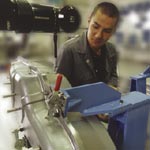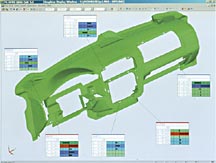
Customers Generally Satisfied With Cars, Appliances, Computers
In the current American Customer,
Japanese automakers were well in front with high quality
and customer satisfaction scores, with European car companies
right behind them" notes Jack West, past president
o
Satisfaction Index, scores for all four sectors in the
manufacturing durables category remained the same: household
appliances at 82, automobiles at 80, consumer electronics
at 81 and personal computers at 71. The overall ACSI score
held steady at 73 (of a possible 100).
This is the third year in a row that the automobile industry
matched its record-high score. Since the inception of the
ACSI, the industry average has remained between 78 and 80
points. "When the ACSI started in 1994f the American
Society for Quality and co-sponsor of the ACSI. "U.S.
auto manufacturers trailed both, but today they've pulled
just about even with Japanese automakers, and European companies
have a narrow lead."
The ACSI score for household appliances remains high and
unchanged, much like it has in the nine years since ACSI
began. "From a competitive point of view, nobody seems
to have an edge," comments Claes Fornell, director
of the University of Michigan Business School's National
Quality Research Center, which compiles and analyzes the
ACSI data.
Although the ACSI score for personal computers didn't
change from last year, customer satisfaction with PCs is
below what it used to be and lags the overall ACSI average,
says Fornell. Dell continues to lead the industry at 76,
but it's still 5 points lower than two years ago.
In addition to manufacturing durables, this quarter's
ACSI looked at Internet business, including Web portals,
search engines and news sites. The score for portals has
climbed from 63 in 2000 to 65 in 2001 to 68 this year, with
every measured portal showing improvement from last year.
Search engines scored 68 overall, with Google leading
the pack at 80 points. Ask Jeeves and Alta Vista were well
behind at 62 and 61 respectively. "Google has much
higher customer loyalty than its competitors because it
provides faster delivery speeds and more relevant results
than other search engines, receiving about 150 million queries
per day," comments Fornell.
Among news and information sites, ABCNews.com topped the
list, with MSNBC.com, CNN.com, NYTimes.com and USAToday.com
following.
The ACSI is produced through a partnership of the University
of Michigan Business School, ASQ and the CFI Group. A complete
list of scores can be found at the U-M Business School Web
site at www.bus.umich.edu/acsi
and ASQ's Web site at www.asq.org.
Reconfigurable Machine Tool Promises Enhanced
Flexibility
Engineers at the University
of Michigan have created a full-scale reconfigurable machine
tool, the first of its kind, according to the NSF Engineering
Research Center for Reconfigurable Manu-facturing Systems.
"Instead of building new factories to manufacture
a new product or introduce a new technology, companies will
build factories for a product family and simply upgrade
with new capabilities," says Yoram Koren, director
of the ERC/RMS.
Reconfigurable machine tools are machines whose structures
can be changed to provide either alternative functionality
or upgrade capacity on demand. The RMT can either be returned
to its initial form or further modified to provide new functionality.
RMTs are designed around common characteristics of part
families, allowing them to create several types of a part.
For example, the RMT is capable of cutting cylinder heads
for vehicles of any major automobile manufacturer. Theoretically,
manufacturers with an RMT can switch from building one type
of cylinder head to another within a few hours.
The Arch-Type RMT has three principal axes of motion,
and its primary use is for milling and drilling on inclined
surfaces of parts made of aluminum. It's also capable of
performing contour cuts on inclined surfaces and cutting
cast-iron parts under limited performance requirements.
For specifications on the Arch-Type RMT, visit erc.engin.umich.edu.
Health Care Quality Rising
Despite some ills, health care
quality is improving, according to a recent report from
the National Committee for Quality Assurance.
More than 6,000 deaths and 22 million sick days could
be avoided if more organizations adopted best practices
found at top health care facilities, the report states.
However, despite these numbers and growing concern over
cost, patient safety and insurance issues, the State of
Health Care Quality report has recorded improvements in
health care performance during the last few years.
Key measures among various health plans, including Medicaid,
Medicare and commercial insurers, have shown progress since
1999. For example, between 2000 and 2001, the percent of
patients whose blood pressure was under control rose from
51.5 percent to 55.4 percent, up from 39 percent in 1999.
Cholesterol control rates, cervical cancer screenings, asthma
medication use, childhood and adolescent immunizations,
diabetes care and post-heart attack treatment have all registered
similar increases.
The report also concludes that care received through commercial
organizations is comparable to care administered by Medicaid
and Medicare; e.g., in 2000 the percent of patients who
received preventive care after a heart attack was 89.4 percent
in commercial organizations, 89.3 percent in Medicare plans
and 82.9 percent in the Medicaid program. In fact, Medicaid
and Medicare outperformed commercial care in several key
measures, including chlamydia screening for women and diabetes
care.
NCQA-accredited organizations outperformed those that
are not, according to the report. For instance, 57.8 percent
of heart attack patients enrolled in accredited organizations
had properly controlled cholesterol levels, whereas nonaccredited
plans showed 44.1 percent control.
JAMA's evaluation
Shortly after the release
of the NCQA's report, the Journal of the American Medical
Association released the report, Relationship Between Low
Quality-of-Care Scores and HMOs' Subsequent Public Disclosure
of Quality-of-Care Scores, which argues that the NCQA's
report doesn't accurately reflect the state of health care
quality.
Currently, public disclosure of data on quality health
maintenance organizations is voluntary. The NCQA lists HMOs'
scores in its annual Quality Compass database, which is
used by health insurance purchasers and consumers. JAMA
contends that HMOs that receive poor scores are likely to
withhold their scores the following year.
According to JAMA, of the 329 HMOs that publicly disclosed
their scores in 1997, 161 plans (49 percent) withdrew from
public disclosure in 1998. Of the 292 HMOs that disclosed
their scores in 1998, 67 plans withdrew from public disclosure
in 1999. Plans whose scores ranked lowest in quality were
more likely to withdraw their scores than high-ranking plans.
"Voluntary reporting of quality data by HMOs is ineffective,"
the report concludes. "Selective nondisclosure undermines
both informed decision making and public accountability.
If health plans that refuse to disclose quality data provide
inferior care, publicly available data would overstate the
average quality of HMO care nationally and result in a distorted
picture of how a given plan compares with that average."
The NCQA argues that JAMA's report is based on outdated
data and that from 2000 and 2001, only five plans refused
to disclose their quality scores.
For more information, visit the NCQA Web site at www.ncqa.org
and JAMA at jama.ama-assn.org.
 New
Law Means Tax Breaks for Machine Purchases New
Law Means Tax Breaks for Machine Purchases
Earlier this year, President
George W. Bush signed an economic stimulus bill that contains
a new 30-percent expensing allowance for new machine tools
and other equipment ordered between Sept. 11, 2001, and
Sept. 11, 2004, and placed in service by Dec. 31, 2004.
"This will mean more job opportunities for workers
in every part of our country, especially in manufacturing
and in high-tech, and for those who work for small businesses,"
Bush said during the March bill-signing ceremony.
The Joint Tax Committee gave the example of a business
that acquired $1 million in equipment this year. The business
would be allowed an additional first-year depreciation deduction
of $300,000. The remaining $700,000 of the adjusted basis
would be recovered this year and subsequent years under
the usual depreciation rules.
"The 30-percent expensing allowance has been quite
significant in helping to move people to buy now as opposed
to waiting," says Jim Mack, vice president of government
relations at the Association for Manufacturing Technology,
which supported the passage of the bill. "The problem
is that no businessperson is going to go out and buy a new
machine simply because he got a tax break. Capacity utilization
rates are still down, and until they come back up, there
aren't going to be a lot of investment decisions."
A main priority for AMT is extending the law past its
expiration date. The association believes the bill would
ideally include a permanent 30-percent expensing allowance,
plus 100-percent expensing of high-productivity equipment,
such as sophisticated machine tools, computers, software
and semiconductor manufacturing equipment.
"This is a direction that I think a fair number of
folks in the administration and in congress would ultimately
like to move," notes Mack. "The 30-percent allowance
is a step in that general direction."
A fact sheet explaining the bill is available at AMT's
Web site at www.mfgtech.org.
 Things
Could Be Looking Up for Metrology Market Things
Could Be Looking Up for Metrology Market
Although it has recorded two
consecutive years of declining dimensional metrology equipment
sales, the Metrology Automation Association predicts a slight
upturn in 2002's third quarter, according to a recent industry
outlook survey.
Year-end statistics from MAA show that CMM sales fell
33 percent in 2001, after falling 34 percent in 2000. The
CMM market had sales of $169.3 million, with 1,597 units
shipped in 2001.
The good news is that respondents to the survey predict
a 2-percent gain in the third quarter. "Our data suggests
some positive movement in the industry," says Donald
A. Vincent, executive vice president of MAA. "We're
not out of the woods, but it would be an improvement of
sorts. We continue to have to take a long-term view on where
the CMM business is going."
The latest data from the U.S. Department of Commerce reflects
the MAA's findings. Indicating that the nation's economic
recovery is weaker than first believed, the Commerce Department
found that second quarter output grew at an annualized 1.1
percent compared to the 5-percent growth rate in the first
quarter.
The Federal Reserve Bank of Atlanta predicts 2- to 3-percent
growth in the gross domestic product in the second half
of 2002, with more momentum building in 2003.
The MAA collects and reports annual market data based
on confidential totals provided by MAA supplier members.
Founded in 1999, the MAA is the only trade group in North
America organized exclusively to promote the use of metrology
automation. Its member companies include metrology equipment
manufacturers, end users, research groups and consulting
firms. Learn more at www.metrologyautomation.org.
ASQ to Launch Community Outreach Program
As part of its goal to prove
the effectiveness of quality at all levels, the American
Society for Quality is in the process of creating procedures
for the Community Good Works Program, which will provide
matching grants and knowledge to local communities involved
in improvement efforts.
 "The
Good Works Program is just one of several initiatives ASQ
has launched to highlight the potential of quality to benefit
humanity," says Daniel Duhan, vice president of ASQ.
"We're in the process of creating implementation policies
and procedures and identifying potential pilot projects." "The
Good Works Program is just one of several initiatives ASQ
has launched to highlight the potential of quality to benefit
humanity," says Daniel Duhan, vice president of ASQ.
"We're in the process of creating implementation policies
and procedures and identifying potential pilot projects."
Candidates for grants include not-for-profit, community-based
or -serving organizations with 501(c)(3) tax-exempt status.
Local government agencies are also acceptable. To qualify
for ASQ's pilot program, organizations must:
 Provide a good story on how to improve communities using
quality tools
Provide a good story on how to improve communities using
quality tools
 Provide excellent ASQ volunteer opportunities
Provide excellent ASQ volunteer opportunities
 Provide a long-term benefit to the community and ASQ
Provide a long-term benefit to the community and ASQ
 Focus on services over products
Focus on services over products
 Focus on results over techniques
Focus on results over techniques
 Have an infrastructure that can support long-term success
Have an infrastructure that can support long-term success
Activities involving individuals, for-profit organizations,
capital fund drives, endowments, real estate purchases,
political activities, lobbying and religious organizations
are not eligible.
To recommend a project for the pilot program, e-mail Duhan
at daniel_m_ duhan@md.northgrum.com and provide the organization's
mission statement, a brief description of the potential
project along with the issues to be addressed, the target
population, approximate costs, a description of how the
project's success will provide evidence of quality's effectiveness
and the grant amount.
ASQ's goal is to award the initial matching grants in
January 2003.
Industry
News
 LMI
Selcom Expands Laser Measurement Capabilities LMI
Selcom Expands Laser Measurement Capabilities
LMI Selcom, a developer of noncontact laser measurement
solutions, has expanded its capabilities into designing
and manufacturing customized sensors for large OEMs.
Typical measurements performed with LMI Selcom's products
include oscillation, thickness, contact height, paper-thickness
profile, material deformation, width, height, long-range
and roller-gap measurement, and 3-D surface scanning.
To learn more, visit www.lmint.com.
Benchmarked Manufacturers Share Insights
 Performance
measurement is crucial to managing manufacturing performance
at factories producing high-tech industrial products, according
to a new study by Best Practices LLC. Performance
measurement is crucial to managing manufacturing performance
at factories producing high-tech industrial products, according
to a new study by Best Practices LLC.
"Metrics for Excellence in Industrial Equipment Manufacturing"
includes information on finished goods inventory turns,
works-in-progress inventory turns, manufacturing cycle time,
on-time delivery rate and customer lead time. It also contains
manufacturers' insights on increasing productivity, boosting
inventory turns and cutting lead times.
A report summary is available at www.benchmarkingreports.com/r/r280.htm.
 Small
Business Gets Lean Small
Business Gets Lean
The New Mexico Manufacturing Extension Partnership, an
affiliate of the National Institute of Standards and Technology,
has successfully assisted Sisneros Brothers Manufacturing
Co., a Belen, New Mexico-based sheet metal fabricating company,
in improving product flow and increasing profit margins
through lean manufacturing.
The national MEP is a network of manufacturing extension
centers that provide assistance to smaller manufacturers
in the United States. Learn more at www.mep.nist.gov.
 Renishaw
Implements PC-DMIS Renishaw
Implements PC-DMIS
Renishaw has adopted PC-DMIS measurement and inspection
software for its coordinate measuring machines. The company
cited benefits to the common platform, including a reduction
in code development times, increased cost savings in maintenance
and calibration, improved data management and more efficient
off-line programming operations. Renishaw will use PC-DMIS's
CAD interface to develop part programs from CAD drawings.
PC-DMIS offers data gathering and analysis functions and
a configurable graphic user interface. It can be installed
on any CMM, regardless of brand. Learn more at www.renishaw.com
or www.wilcoxassoc.com
|